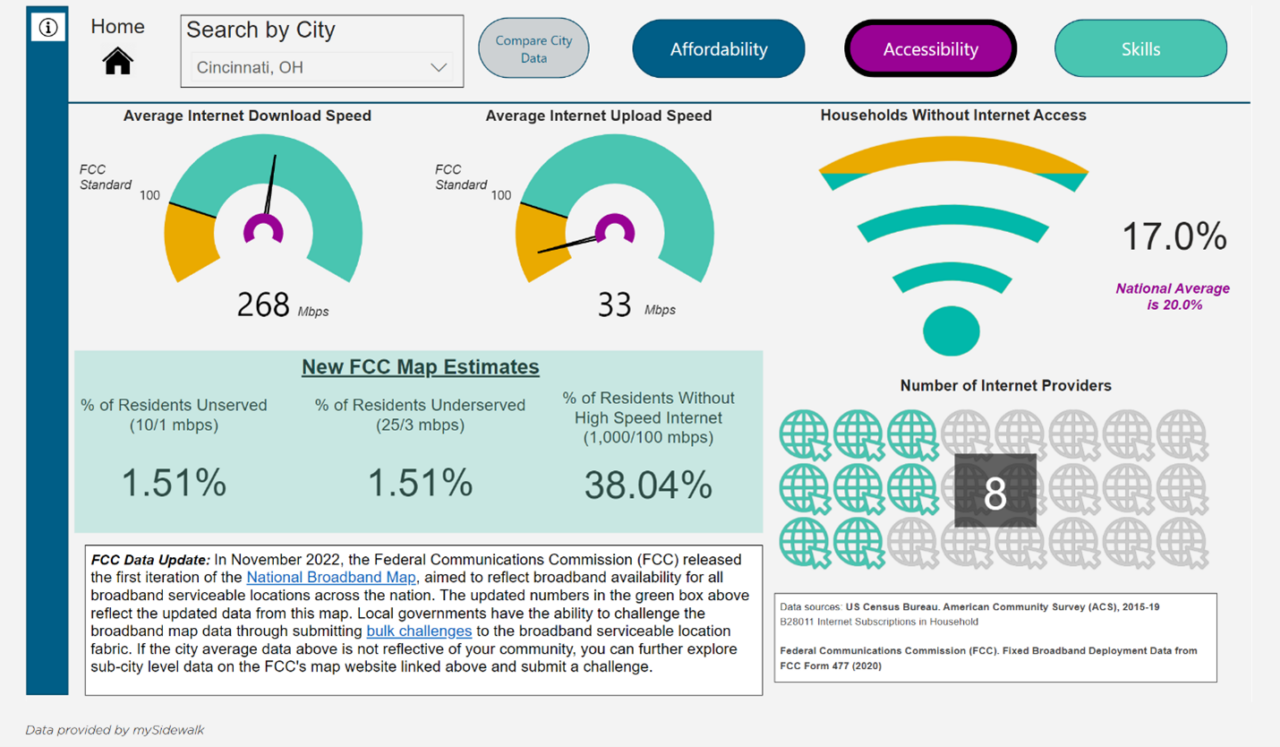On November 18, the Federal Communications Commission (FCC) released the first iteration of the National Broadband Map, a web-based interactive map aimed to reflect broadband availability for all broadband serviceable locations across the nation. This map is an important tool that will impact targeted funding and other efforts to bring broadband to unserved and underserved communities. Therefore, the need for accurate data where broadband service is available and not available has never been of greater importance.
Importantly, the release of the map also kicks off the public fixed availability challenge process, which will play an important role in ensuring the map’s data is accurate across local communities. Local governments have already been able to challenge the broadband map data through submitting bulk challenges to the broadband serviceable location fabric, which serves as the common dataset of all locations in the United States where fixed broadband internet access service is or can be installed.
Local governments will greatly benefit from being active and engaged in the challenge process to the National Broadband Map. To assist cities, towns and villages in determining whether they need to submit a challenge, NLC has updated the digital equity needs assessment dashboard with additional metrics. While we encourage you to go to the map interface and validate the data shown in the map, NLC’s Digital Equity Broadband Needs Assessment Dashboard may also serve as an additional indicator to disparities between the local experiences and FCC data.
To find these indicators, use the link above to take you to the webpage and click on the “Accessibility” button in the dashboard. You can them search for your city to be taken to the metrics shown below.

Below are some other questions and resources that may help local governments initiate a plan to challenge any inaccuracies in the National Broadband Map.
What Type of Data Can I Challenge?
After searching and identifying an address on the map, the menu for fixed broadband will allow for a location challenge or availability challenge.
To challenge information on the location, find the “Location Challenge” text on the right-side menu and select. A web-form will populate which will prompt challengers to submit a series of information. The form requires challengers to add in their contact information, the challenge type (see categories below), documentation evidence supporting the challenge (such as a written description of how the map is reflecting the incorrect information), and a certification from the individual that the information submitted is true and correct along with other statements.
Location Challenges are Appropriate to File for the Following Circumstances:
- Incorrect location address
- Incorrect location unit count
- Location is not within the correct building footprint
- Location is not broadband serviceable
- Add additional address for the location
- Incorrect location building type
To challenge information on the availability of broadband at the location, find the “Availability Challenge” text on the right-hand menu and select. Again, a form will auto-populate that shows the providers that serve the location, the technology they use, along with the download and upload speed in Mbps. Challengers may select the provider under which they would like to submit availability challenges to the information shown in the chart. They will then need to complete a form with their contact information, what the dispute is with the availability (provider) data, enter in information describing their experience and adding any evidence of the dispute, and a certification from the individual that the information submitted is true and correct along with other statements. Under availability challenges, providers will receive all challenges that meet the criteria for a challenge to address.
Availability Challenges are Appropriate to File for the Following Circumstances:
- The provider does not offer services to this location
- The technology type is inaccurate as shown
- The download or upload speed as indicated is not accurate
- Other related availability disputes
How Can I Challenge?
The FCC has released a document to assist local governments in submitting a challenge. Additionally, local leaders can consider launching a public campaign in their community for their residents and community members to search their own address and review and validate the information at their location. Challenges on fixed availability can be submitted on any web-supported device such as a laptop, mobile phone, laptop, or on a public computer.
When Should I Challenge?
While the FCC has shared that the challenge process will remain open so that users of the National Broadband Map can continue to challenge and improve the accuracy of the map, there is an important deadline approaching to be mindful of. The National Telecommunications and Information Administration (NTIA) is the federal agency administering the Broadband, Equity, Access, and Deployment (BEAD) Grant Program, the largest broadband program created by the Infrastructure, Investment and Jobs Act with a funding pool of nearly $42.5 billion. The funding allocations will be impacted, in part, by the data that is in the maps. NTIA has announced that challenges should be submitted by a deadline of January 13, 2023, to be considered in the final version of the map that will be used in allocating the BEAD funding.
However, the BEAD allocations are just one program that will benefit from the use of the data in the National Broadband Map. The need for continuous quality improvements on the information in the map are important to ensure that future funding determinations are made on the most accurate data to reach the areas that need funding the most. Additionally, the maps serve important purposes beyond being a tool for funding determinations, such as providing greater transparency to individuals on availability to their location, putting pressure on internet providers to improve their coverage, and helping policymakers have the most accurate and granular information to meet the needs of a given region or community.











